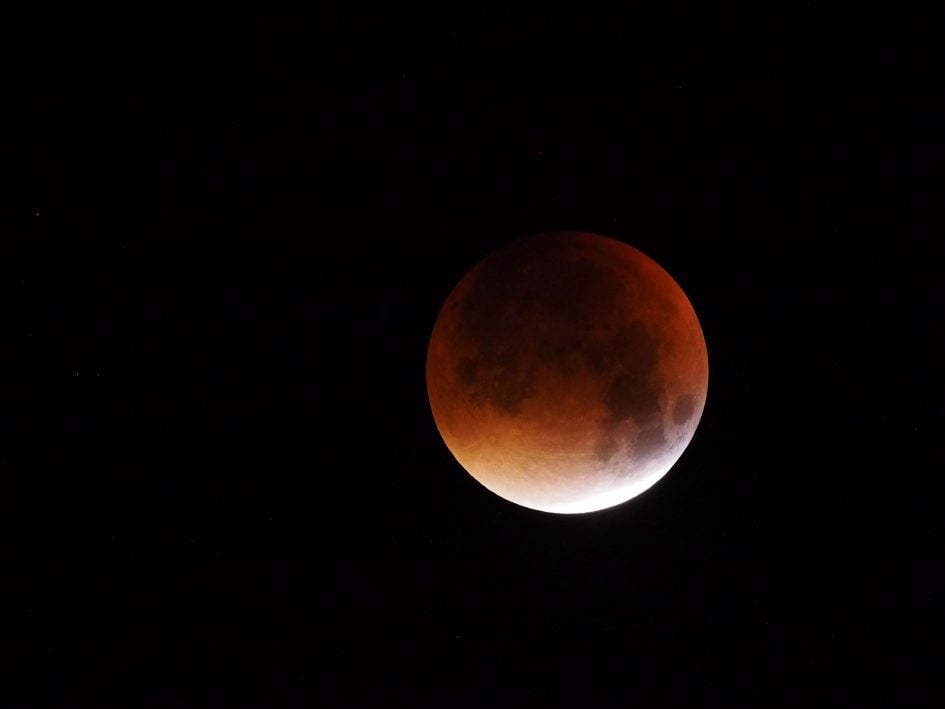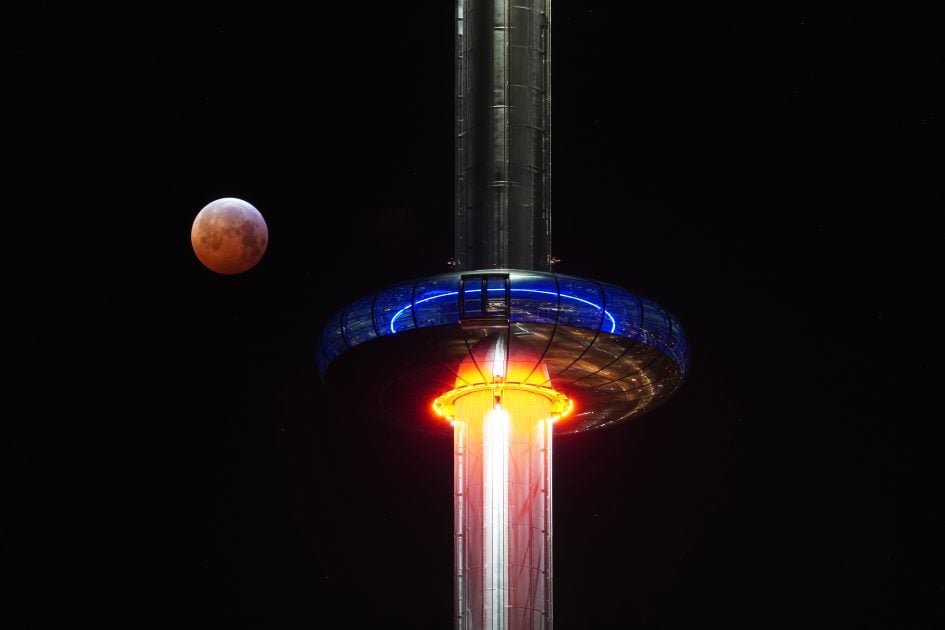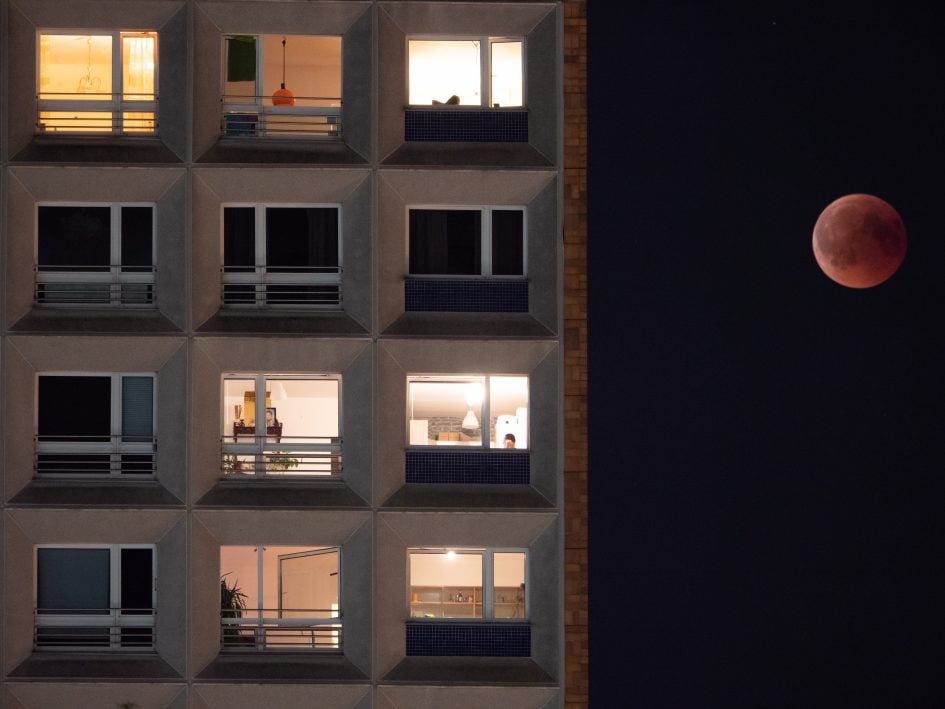What Are The Best Camera Settings For Lunar Eclipse
Lunar Eclipse Photography -
- Written by
A Full Lunar Eclipse is one of Nature'southward almost spectacular displays and a great deal easier to photograph than a Solar Eclipse, not to mention more than frequent too. During a Lunar Eclipse, the Earth gets in the style of the Sun and Moon, casting its shadow over the Moon's surface. As more of the shadow crosses the Moon, you'll notice this area is not completely dark, simply dimly illuminated by blood-red calorie-free which has passed through our atmosphere.
In the following video tutorial I'll show you everything you need to know about photographing a Lunar Eclipse, although if you lot prefer to read a written version, keep scrolling!

Above: Lunar Eclipse simply before totality. 1080mm equivalent focal length. Uncropped paradigm.
My favourite part of a Lunar Eclipse occurs a infinitesimal or two before or afterwards Totality when y'all can expose for this dark shadowy area, revealing the dull red colour, while grossly overexposing the sliver that's nevertheless illuminated by the Sun. That'due south what I did for the epitome above during the Full Lunar Eclipse of September 28 2015. I used an Olympus OMD EM1 mounted on my Televue Genesis SDF telescope – using it as a 540mm f5.4 telephoto lens. The two-times field reduction of the EM1'south sensor effectively doubled the focal length to 1080mm and the paradigm here you see is uncropped. You lot can of form shoot it with a shorter lens, such as a 70-300mm zoom, then crop the prototype for a closer-await. Or y'all could go deliberately wide and comprise some of the landscape or an attractive building. For me this is where the real creativity lies, so e'er see if you can comprise a building or natural element in your composition, like the eclipsed Moon ascent over a mount or alongside a famous tower. Mobile apps which exploit Augmented Reality to preview the position of the Moon in an bodily scene are invaluable – I employ Sun Surveyor for Android.

Above: Totality in Brighton, UK, January 21st 2019. Sony A6400 and Fe seventy-200mm at 200mm (300mm equiv), uncropped. one sec, f5.6, 800 ISO.

To a higher place: Totality in Berlin, Germany, July 27th 2018. Lumix G9 and Leica fifty-200mm at 200mm (400mm equiv), uncropped. 0.8secs, f5, 800 ISO.
Whatever lens you use, it's all-time to pre-focus on the Moon, confirming with magnified assist, then switch to manual focus to prevent whatever adventitious searching. I'd also suggest setting the White Balance to Daylight.
Now for exposure. The Moon will go through a huge range of brightness during a Total Eclipse, starting-off vivid and total earlier gradually darkening and becoming very dim during totality. During the early on phases where only a small notch has been taken out the side, I'd recommend shutter speeds of around 1/lx to 1/250 at 100 ISO and f5.6. As always, this is a starting point. Playback your images and adjust as required. Deport in mind the Moon is much brighter than it looks so ignore your photographic camera's suggested settings or you'll end upwards with a horribly over-exposed featureless white circumvolve.
As more of the Moon is covered in shadow, it volition go much darker. In the moments before or post-obit totality, such every bit in my shot here, yous'll need to increase the sensitivity to 800-3200 ISO and use exposures of around one-half a second at f5.half-dozen. Once again it'due south a starting point. If the paradigm is likewise bright, try a quicker shutter and lower ISO or vice versa. Suffice it to say at this signal y'all should definitely be using a tripod with either a cable release or the self timer to avoid wobbling the camera as you have the shot.
During totality you may need exposures of one or even ii seconds even at 3200 ISO, and if you're using a longer lens, the event of the Earth's rotation volition begin to come up into play. At 500mm, the Moon volition visibly motility a little during a one second exposure, causing some motion mistiness. Unless you have a tracking mount, your but pick to avert this is to keep exposures to less than a second or 2 and simply bump upwardly the ISO until yous get the desired brightness. If the Moon is very low in the heaven and close to the horizon, information technology will too be dimmer than normal and potentially a little distorted besides due to atmospheric furnishings.
Oh, and how do you know when and where the adjacent eclipse will take place? Easy! Caput to MrEclipse, the website of NASA's Eclipse expert Fred Espinak.
These tips are an excerpt from my photography volume, In Camera, which features the stories and techniques behind 100 of my favourite photos, all JPEGs, all In Camera! If you institute this article useful, care for yourself to a copy, spend less time post processing and support Cameralabs all in one become, thanks!
Cheque prices at Amazon, B&H, Adorama, eBay or Wex. Alternatively get yourself a copy of my In Camera book or treat me to a coffee! Thanks!Source: https://www.cameralabs.com/lunar-eclipse-photography/
Posted by: taylorhimbeyer.blogspot.com


0 Response to "What Are The Best Camera Settings For Lunar Eclipse"
Post a Comment